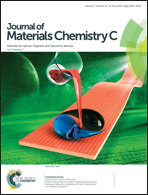Thermal stabilization and energy transfer in narrow-band red-emitting Sr[(Mg2Al2)1−y(Li2Si2)yN4]:Eu2+ phosphors†
Abstract
Cuboid-coordinated nitridomagnesoaluminate Sr[Mg2Al2N4]:Eu2+ and a solid solution of Sr1−x[(Mg2Al2)1−y(Al2Si2)yN4]:Eux2+ were prepared using all-nitride precursors by gas pressure sintering. X-ray diffraction (XRD) data of the phosphors were validated by Rietveld refinement of synchrotron X-ray powder XRD data with the space group I4/m indexed to a tetragonal crystal system. The 7Li solid-state magic-angle spinning nuclear magnetic resonance (ss-MAS-NMR) data prove the successful incorporation of the Li+–Si4+ couple. The blue-light excitable property with the excitation band peaking at 460 nm gave rise to emission at 620–630 nm at x = 0.004, with a full-width-at-half-maximum of ∼77 nm. The inhomogeneous broadening of the Eu2+ luminescence in the system due to the effective energy transfer from one activator to another was observed which concurrently resulted in spectral peak shifts from ∼615 nm to ∼680 nm as a function of the amount of Eu2+. The Li+–Si4+-tuned solid solution increased the emission intensity without significantly shifting the emission wavelength. Such a phenomenon was accompanied by an improvement in thermal stability from Δ = 965 cm−1 for y = 0, to Δ = 1365 cm−1 for y = 0.1 wherein Δ corresponds to the activation energy from the 5d states to the conduction band. The simple gas pressure sintering strategy using all-nitride starting materials resulted in the desired blue light-excitable narrowband red emitting thermally stabilized phosphor.
![Graphical abstract: Thermal stabilization and energy transfer in narrow-band red-emitting Sr[(Mg2Al2)1−y(Li2Si2)yN4]:Eu2+ phosphors](/en/Image/Get?imageInfo.ImageType=GA&imageInfo.ImageIdentifier.ManuscriptID=C7TC05613C&imageInfo.ImageIdentifier.Year=2018)


 Please wait while we load your content...
Please wait while we load your content...